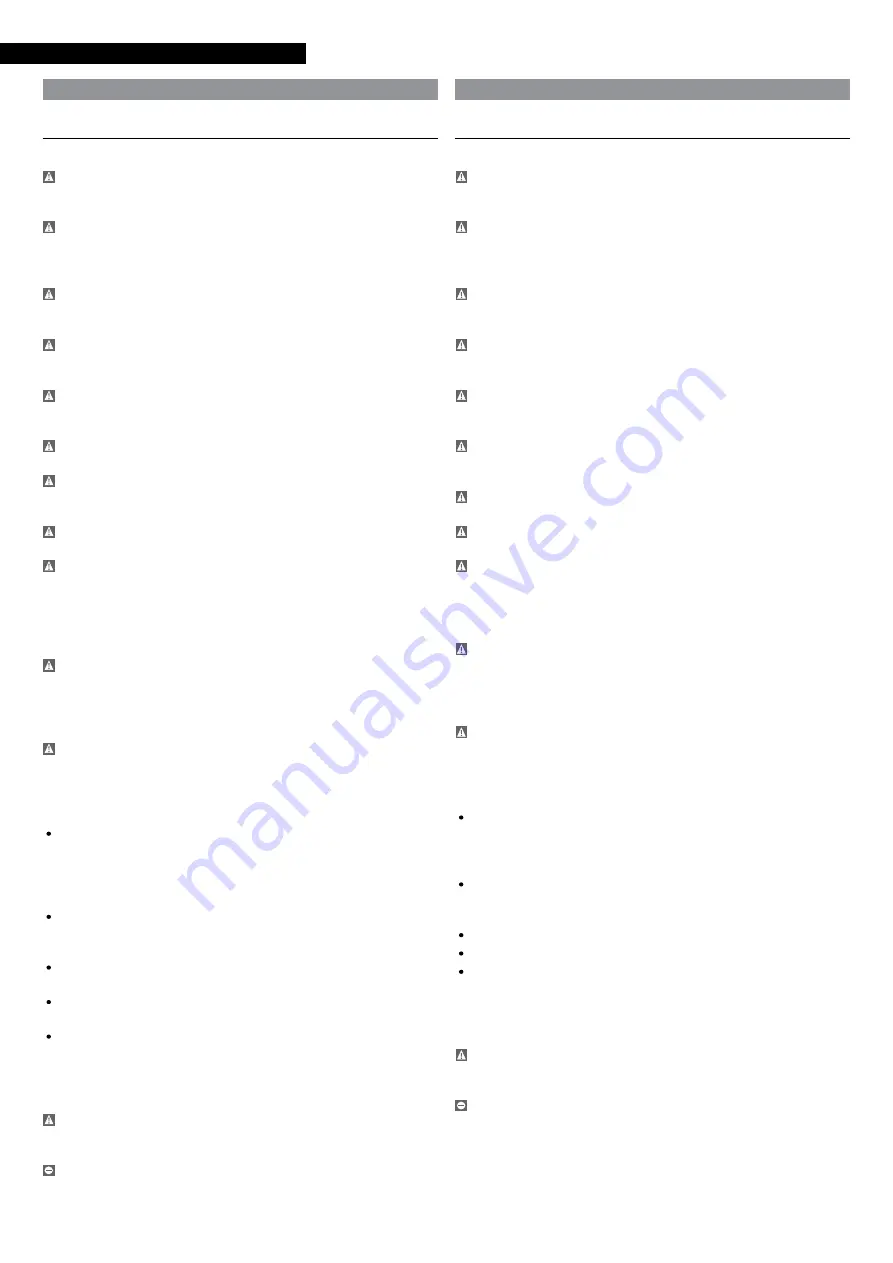
NExSIRIUS
34
EN
22 hydraulic connections
Preliminary warnings
Detailed specifications for the unit (data, measure-
ments, dimensions, fittings, space restrictions, etc.) are
given in section “Technical specifications”
p. 10.
The choice and installation of system components is left
to the skilled installer, who shall operate pursuant to
the best practices and the legislation from time to time
in force.
Make sure that there are no stones, sand, rust, dirt or
foreign bodies in the pipes/hoses as these could dam-
age the system.
We recommend that you fit a bypass to the unit so that
pipes/hoses can be flushed out without having to dis-
connect the unit.
Connecting pipes/hoses must be of suitable diameter
and must be correctly supported so that they do not
weigh on the unit.
Systems filled with anti-freeze or fitted with legally
permitted frost protection devices must also be fitted
with water disconnectors.
Check the pressure drops of the unit, system, and all
accessories in the circuit.
The water flow must always be steady during the oper-
ation, with a water
∆
T of 5 - 6 °C.
Do not use the heat pump for treating industrial water,
swimming pool water or domestic water. If water sup-
plies of this kind are used, an intermediate heat ex-
changer must be used. Make sure to maintain the min.
water content, possibly adding a storage.
The expansion vessel supplied as standard on the ma-
chine enables the arrangement of a floor system (tem-
perature difference from 20 °C to 35 °C) with water con-
tent up to 280 l or a fan coil system (temperature differ-
ence from 7 °C to 45 °C) with water content up to 120 l.
If the equipment is connected in parallel with a boiler,
when the latter is operating make sure that the tem-
perature of the water circulating inside the heat pump
does not exceed 60 °C.
Mandatory items:
Install an extractable mesh water filter of min. 10 mesh-
es/inch² at the equipment inlet in an area accessible for
maintenance, to safeguard the equipment from impu-
rities inside the water.
After installing the system and after any repair it is in-
dispensable to carefully clean the entire system, paying
special attention to the filter conditions.
Install vent valves at the highest points of the piping.
Use flexible elastic joints to connect the pipes.
Make sure that the water quantity in the primary circuit
is higher than the min. volume indicated in the techni-
cal data table, to prevent any risk of ice formation dur-
ing the defrosting operations or the continuous fre-
quency modulation of the compressor.
To ensure better comfort and the best performance a
water volume on the primary circuit of at least 6 l/kW is
recommended.
It is forbidden to run the unit without a clean water
filter installed.
IT
22 Collegamenti idraulici
Avvertenze preliminari
Le informazioni di dettaglio sulla macchina (dati, misure,
dimensioni, attacchi, spazi di rispetto, ecc.) sono riportate
nel capitolo “Dati tecnici”
p. 10.
La scelta e l’installazione dei componenti dell’impianto è
demandato per competenza all’installatore, che dovrà
operare secondo le regole della buona tecnica e della
Legislazione vigente.
Assicurarsi che le tubazioni non contengano sassi, sabbia,
ruggine, scorie o comunque corpi estranei che potrebbero
danneggiare l’impianto.
È opportuno realizzare un by-pass dell’unità per poter
eseguire il lavaggio delle tubazioni senza dover scollegare
l’apparecchio.
Le tubazioni di collegamento devono essere di diametro
adeguato e sostenute in modo da non gravare, con il loro
peso, sull’apparecchio.
Gli impianti caricati con antigelo o disposizioni legislative
particolari, obbligano l’impiego di disconnettori idrici.
Verificare le perdite di carico dell’apparecchio, dell’im-
pianto, e di tutti gli altri eventuali accessori montati in li-
nea.
La portata d’acqua deve essere inoltre mantenuta costan-
te durante il funzionamento, con un
∆
T acqua di 5 - 6 °C.
Non utilizzare la pompa di calore per trattare acqua di pro-
cesso industriale, acqua di piscine o acqua sanitaria. In
tutti questi casi predisporre uno scambiatore di calore in-
termedio. Assicurarsi in tal caso di rispettare il contenuto
minimo di acqua, eventualmente aggiungendo un accu-
mulo.
Il vaso d’espansione, di serie a bordo macchina, permette
di realizzare un impianto a pavimento (salto termico da 20
°C a 35 °C) con contenuto di acqua fino a 280 litri o un im-
pianto a ventilconvettori (salto termico da 7 °C a 45 °C) con
contenuto di acqua fino a 120 litri.
In caso dell’apparecchio venga collegato in parallelo ad
una caldaia, durante il funzionamento della stessa, assi-
curarsi che la temperatura dell’acqua circolante all’interno
della pompa di calore non superi i 60 °C.
È obbligatorio:
Installare un filtro acqua a rete estraibile in ingresso
all’apparecchio in una zona accessibile alla manutenzio-
ne, con caratteristiche di almeno 10 maglie/pollice², per
salvaguardare l’apparecchio dalle impurità presenti
nell’acqua.
Dopo il montaggio dell’impianto e dopo ogni sua ripara-
zione è indispensabile pulire accuratamente l’intero siste-
ma, prestando particolare attenzione allo stato del filtro.
Installare valvole di sfiato aria nei punti più alti delle tu-
bazioni.
Installare giunti elastici flessibili per il collegamento delle
tubazioni.
Assicurare che la quantità d’acqua nel circuito primario sia
superiore al volume minimo indicato nella tabella dati
tecnici, per prevenire rischi di formazione di ghiaccio du-
rante le operazioni di sbrinamento o la continua modula-
zione della frequenza del compressore.
Per garantire un migliore comfort ed avere prestazioni ot-
timali è consigliato un volume d’acqua sul circuito prima-
rio di almeno 6 l/kW.
È vietato far funzionare l’unità senza il filtro acqua instal-
lato e pulito.
Summary of Contents for NexSirius
Page 99: ......
















































